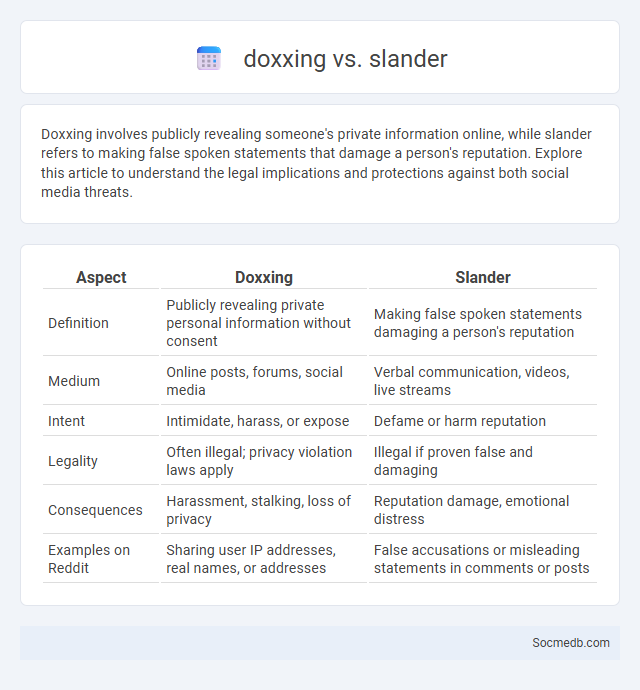
Photo illustration: doxxing vs slander
Doxxing involves publicly revealing someone's private information online, while slander refers to making false spoken statements that damage a person's reputation. Explore this article to understand the legal implications and protections against both social media threats.
Table of Comparison
| Aspect | Doxxing | Slander |
|---|---|---|
| Definition | Publicly revealing private personal information without consent | Making false spoken statements damaging a person's reputation |
| Medium | Online posts, forums, social media | Verbal communication, videos, live streams |
| Intent | Intimidate, harass, or expose | Defame or harm reputation |
| Legality | Often illegal; privacy violation laws apply | Illegal if proven false and damaging |
| Consequences | Harassment, stalking, loss of privacy | Reputation damage, emotional distress |
| Examples on Reddit | Sharing user IP addresses, real names, or addresses | False accusations or misleading statements in comments or posts |
Understanding Doxxing: Definition and Implications
Doxxing involves publicly revealing someone's private information online without their consent, often leading to harassment or identity theft. Understanding doxxing is crucial for protecting your digital privacy and preventing potential risks such as cyberbullying, stalking, or reputational damage. Social media platforms are common venues for doxxing incidents, making awareness and preventive measures essential for your online safety.
What is Slander? Key Legal Differences
Slander involves making false spoken statements that damage a person's reputation, differing from libel, which refers to written defamation. Social media posts can qualify as slander if the defamatory content is delivered via video or audio formats, whereas text-based posts typically fall under libel. Understanding these distinctions is crucial for protecting your rights and responding to harmful online content effectively.
Personal Information Doxxing: Scope and Examples
Personal information doxxing on social media involves the unauthorized publishing of sensitive data such as home addresses, phone numbers, and financial details, which exposes individuals to privacy breaches and potential harassment. High-profile cases include the doxxing of celebrities and activists, where attackers exploit platforms like Twitter and Instagram to disseminate personal information widely. Protecting Your digital footprint requires strict privacy settings, cautious sharing habits, and awareness of the risks associated with oversharing on social networks.
Comparing Doxxing and Slander: Main Distinctions
Doxxing involves the unauthorized public release of private or personal information online, often leading to harassment or threats, while slander refers to making false spoken statements that damage a person's reputation. Doxxing targets an individual's privacy by exposing sensitive data, whereas slander attacks their character through defamatory speech. The primary distinction lies in doxxing's focus on violating privacy through data exposure, compared to slander's focus on reputational harm via false verbal claims.
Legal Ramifications: Doxxing vs. Slander
Doxxing involves publicly revealing private information without consent, exposing individuals to serious privacy violations and potential criminal charges under data protection laws. Slander refers to making false spoken statements damaging to a person's reputation, potentially resulting in civil lawsuits for defamation and monetary damages. Social media platforms increasingly enforce policies to mitigate both doxxing and slander, emphasizing the legal consequences and the importance of respecting digital rights.
Forms of Personal Information Targeted in Doxxing
Doxxing on social media targets various forms of personal information, including full names, home addresses, phone numbers, email addresses, workplace details, and private photographs. Sensitive data such as date of birth, social security numbers, financial information, and family members' identities are also frequently exploited by malicious actors. Exposure of this comprehensive personal data disrupts privacy, enabling harassment, identity theft, and reputational damage.
Real-World Cases: Doxxing and Slander in Action
Social media platforms have become breeding grounds for doxxing, where malicious actors expose personal information like home addresses and phone numbers, putting individuals at risk. Real-world cases highlight severe consequences, including harassment and threats, stemming from such violations of privacy. Understanding these dangers empowers you to safeguard your online presence against slander and harmful disclosures.
Preventing Doxxing and Slander: Safety Tips
Protecting Your personal information on social media platforms is crucial for preventing doxxing and slander that can lead to identity theft or reputational harm. Use strong privacy settings, avoid sharing sensitive details like your home address or phone number, and regularly audit your online presence to identify and remove potentially compromising content. Being cautious about friend requests and messages from unknown users also helps safeguard Your digital footprint against malicious attacks.
Reporting and Responding to Online Attacks
Effective reporting and responding to online attacks ensures your digital safety and preserves your reputation. Utilize platform-specific reporting tools to flag abusive content while documenting incidents with screenshots and timestamps for accuracy. Engaging trusted support networks and adjusting privacy settings enhances protection and fosters a safer social media experience.
Protecting Your Digital Identity: Best Practices
Protecting your digital identity on social media requires strong, unique passwords combined with two-factor authentication to prevent unauthorized access. Regularly reviewing privacy settings on platforms like Facebook, Instagram, and Twitter minimizes data exposure and controls who can view your information. Avoid sharing sensitive personal details and be cautious when accepting friend requests or clicking on suspicious links to reduce the risk of identity theft and phishing attacks.
 socmedb.com
socmedb.com